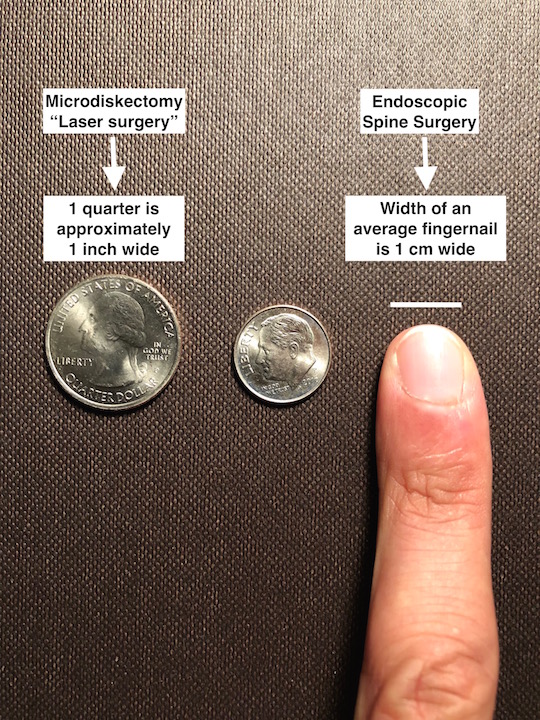
Spine surgery with just a 1 cm incision?
By: ScopeSpine
Endoscopic spine surgery: The latest in minimally invasive spine surgery comes to the DMV area.
Many of us are familiar with arthroscopic surgery. These are common surgeries performed in the knee, shoulder, or hip where a surgeon places a thin tube with a small camera at the end, also simply referred to as a “scope.” Through this small device the surgeon can remove or clean out a joint, remove a torn piece of tissue, or remove bone spurs. The entire procedure is performed through small incisions. Could “scopes” ever be used with spinal surgery?
Endoscopic Spine Surgery: An Incision Smaller Than a Dime
Patients who suffer from a lumbar disc herniation or spinal stenosis now have a new treatment option called endoscopic spine surgery. Unlike traditional spine surgery involving large incisions, endoscopic surgery uses a small incision that is 1cm or less – smaller than a dime (as a reference there are 2.54 cm in one inch). This surgery is less invasive than other minimally invasive procedures such as microdiskectomy (a procedure where the surgeon removes a disc herniation that is pressing on a spinal nerve).
Endoscopic Diskectomy vs. Microdiskectomy
Many patients get confused between endoscopic diskectomy and microdiskectomy. Although both endoscopic diskectomy and microdiskectomy sound similar, they are quite different in their approach and technique. Endoscopic surgeries use a scope, a narrow tool with a small camera and light source at the end. In contrast, a microdiskectomy often requires a microscope. With a microscope, the surgeon still needs to use larger tubes or retractors to enter the spine. These larger tools are not needed with endoscopic diskectomies. This difference in approach is why endoscopics is less invasive, and can be performed with a smaller incision. Yes, endoscopic diskectomies can be performed with incisions smaller than popularly advertised “laser diskectomies.”

Image 1: Shows the differences in lengths of incisions performed for common spinal procedures. Microdiskectomy surgeries are frequently performed through an incision approximately 1-2 inches long. One inch is approximately the length of a quarter. Laser diskectomies are frequently advertised in the media as being approximately 1 inch as well. Endoscopic diskectomies, are the least invasive. They are performed through an incision 1cm in length, or approximately the width of an average fingernail.

Image 2: Shows the incision for an endoscopic diskectomy. These procedures are performed on an outpatient basis. Patients can go home shortly after the surgery.
Why has it taken so long for endoscopes to be used in the spine?
Most endoscopic surgeries are performed in joints or larger organs, where there is more freedom to move surgical tools. The spine is limited by the small space to place instruments. Today, with advancements in technology and optics/cameras, we can safely use these tools in the spine with a very small incision.
Who is a candidate?
The ideal patient who can benefit from endoscopic spine surgery is a patient who has either a disc herniation or spinal stenosis. Typically, these patients will have back and leg pain. If medications, therapy, and injections fail to work, then endoscopic spine surgery is a reasonable option to consider. The procedure is a same day procedure, and the patient can go home shortly after the operation.
Where can you learn more about endoscopic spine surgery?
If you are a patient with back or leg pain and have found no relief with conservative treatments, you may be a candidate for endoscopic spine surgery. This latest option in minimally invasive spinal surgery is now available to all patients in the DC, Maryland, and Virginia region. For more information about endoscopic spine surgery, and how the procedure is performed, please visit: www.scopespine.com

About Dr. Usman Zahir
For five years Dr. Zahir was Clinical Assistant Professor of Orthopaedic Surgery at Georgetown University Hospital. Currently, he practices in Central and Northern Virginia and continues to teach others about endoscopic spine surgery. He was the first surgeon in Virginia to use a newly released endoscopic device in 2017 designed to treat lumbar stenosis, the iLESSYS® Delta Joimax endoscopic spine system. Dr. Zahir is trained on three separate endoscopic spine systems.
To learn more about Dr. Zahir or schedule an appointment, please visit: https://www.usmanzahir.com/



